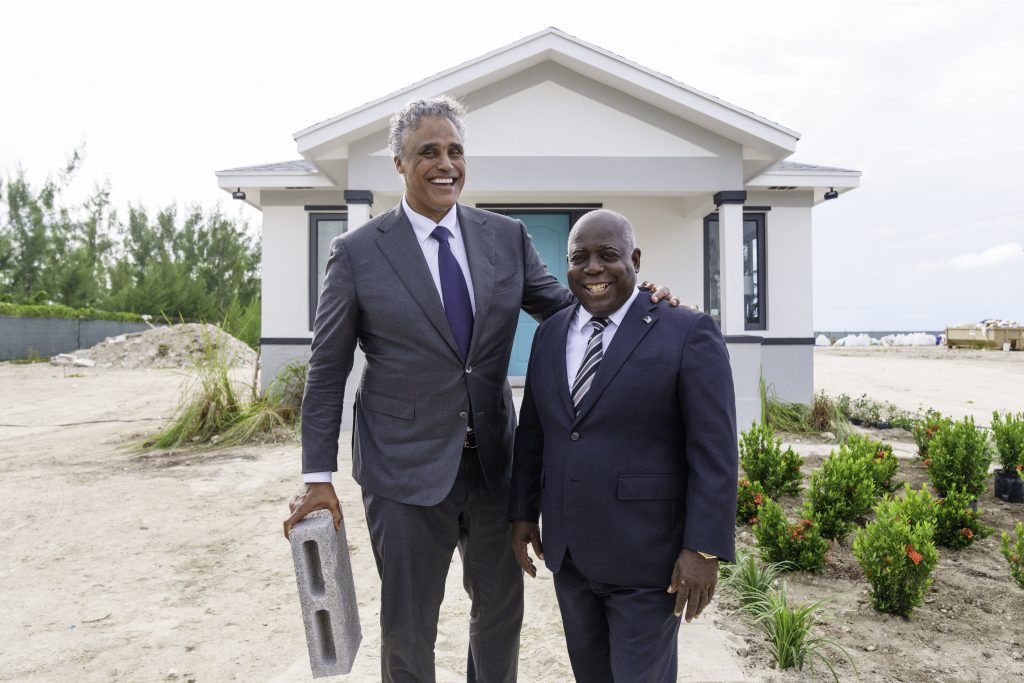“Partanna’s carbon-negative concrete is set to change the world.” This bold statement doesn’t come from an architect or a material scientist, but from Rick Fox, a former Los Angeles Lakers small forward with three NBA championships under his belt, as well as a prolific career in Hollywood.
Fox, seated at an open-air café in Riyadh, Saudi Arabia’s capital, speaks about his startup, Partanna, with an infectious enthusiasm. His eyes gleam with the kind of vitality that belies his age, making the fifty-something former NBA star seem as if he’s in his twenties again, ready to conquer the basketball court with the same radiance and vigor.
Yet, this time, his arena is neither the basketball court nor the silver screen, but rather the centuries-old traditional industry of cement and concrete.
Founding Partanna
“A lot of people are asking me what I’m up to,” Fox shares, noting the widespread bewilderment at his pivot to the concrete industry. But for him, this venture isn’t merely a new, intriguing experiment; it represents a crucial mission for the latter half of his life.
“Honestly, I never envisioned myself getting into this industry,” Fox reflects. The founding of Partanna wasn’t so much a calculated move as it was a convergence of the right time, place, and people—a happenstance that motivated Fox to embrace the challenges of starting a new business.
In 2019, the unprecedented power of Hurricane Dorian, described as a “monster” storm, wrought catastrophic damage upon The Bahamas, marking the most severe weather disaster in the nation’s history. The Bahamas, where Fox hails from, witnessed devastating destruction and thousands were left homeless.
Seeing his childhood home in ruins, Fox understood that simply donating money was not enough. “Global warming is unleashing unprecedented challenges for humanity, leading to more frequent and more powerful hurricanes. The Bahamas can’t afford to wait; we need stronger houses right now.”
Then, the COVID-19 pandemic erupted globally, acting as a catalyst for the inception of Partanna.
Through a mutual acquaintance, Fox was introduced to Sam Marshall, the cofounder of Partanna. Marshall, an architect who, along with his team had developed a patented new material poised to replace traditional cement, but he lacked the experience to bring it to market. “I began to delve deeply into Sam Marshall’s formula. The global lockdown meant we all had nowhere to go, and suddenly, everyone found themselves with an abundance of time. Sam and I ended up talking for days on end,” Fox recounted. The two instantly clicked, and from those conversations, Partanna was born.
Starting from the manufacturing process itself, Partanna aims to revolutionize the cement industry by creating a new type of concrete that “acts like a tree”: a carbon negative, climate resilient cement that works just as well above land as under water.
The Science of Carbon Negative Cement
What exactly is Partanna? To answer this, it’s important to first understand the processes behind cement and concrete production.
Cement acts as a binder and is a key ingredient in producing concrete. Concrete, in turn, is the most widely used man-made material on the planet, second only to water in terms of consumption.
The cement production process begins with the extraction of raw materials, primarily limestone and clay. These materials are then ground into a raw mix and sent to a rotary kiln, where they are subjected to high temperatures of around 1,500 degrees Celsius in a process known as calcination. The material is then ground into a fine powder with additives to produce the widely used cement.
This calcination stage, with its high-temperature treatment, emits a significant amount of carbon dioxide. Globally, it accounts for approximately 9% of all carbon emissions, which makes it a significant contributor to climate change.
Partanna uniquely bypasses the high-temperature calcination stage required for manufacturing traditional cement clinkers, making it carbon neutral to produce. Eight years ago, Sam Marshall stumbled upon a discovery: a combination of brine, a by-product of the seawater desalination process, and steel slag, a waste material from steel manufacturing. He refined and upgraded these two materials, ultimately creating a new type of binder that has been patented and can fully replace Portland Cement.
Once cement is produced, it is sold to downstream industries such as construction and public works manufacturers, who then use it to create various cement-based products like concrete, CMU (concrete masonry units) blocks, flooring materials, walls, and pipes.
Traditional concrete production involves mixing water and aggregates with Portland Cement to serve as the binder. What sets Partanna’s carbon-negative concrete apart is its innovative use of the natural waste materials described earlier as a new type of binder, effectively replacing traditional Portland Cement.
Fox explains that these mixtures, once activated by saline water, can cure at room temperature. Due to the unique composition of the Partanna binder, the curing process absorbs carbon dioxide, effectively removing it directly from the atmosphere. “We’re not just a carbon storage technology; we’re more like trees, directly absorbing CO2 from the air,” Fox clarifies. Partanna Cement is therefore carbon neutral to produce, but ultimately is carbon negative, as it absorbs CO2 when it cures and throughout its lifecycle as it gets exposed again and again to elevated humidity or rain water which activates more carbon absorption.
The concrete produced by Partanna can be used in large-scale infrastructure projects, seawalls, residential buildings, and roads, offering durability that matches traditional materials. Moreover, because it utilizes brine as a raw material, the concrete becomes even more resilient when exposed to seawater, making it particularly suitable for constructions in coastal areas where saltwater corrosion is a concern.
From a carbon emission reduction perspective, Partanna’s process sidesteps the high-temperature calcination, producing a binder that replaces cement without emitting greenhouse gases. In terms of waste recycling, Partanna repurposes steel slag and brine, both of which are harmful by-products of industrial processes. Additionally, the production of Partanna’s carbon-negative concrete does not require filtered water like traditional concrete, further reducing the consumption of water resources during the manufacturing process.
Regarding carbon dioxide absorption, Partanna’s carbon-negative concrete actively draws CO2 from the air as it cures, and beyond. According to Partanna’s data, a traditional concrete house covering 1,250 square feet (about 116 square meters) generates 70.2 tons of carbon dioxide. In contrast, a house of the same size built with Partanna concrete can remove 182.6 tons of CO2, equivalent to the absorption capacity of 5,200 trees. This makes it the world’s first fully cement-free, carbon-absorbing “carbon-negative” building material.
Put simply, Partanna stands as the world’s first company to successfully bring carbon-negative concrete out of the lab and into commercial-scale production. “It was imperative that this material was introduced to the world,” Fox asserts.
Going from Laboratory to Market
For three years, from facing daily rejections to now securing buy-ins from the Bahamian government, concrete equipment manufacturers, and major real estate developers, the journey wasn’t always easy – but it was worthwhile.
The construction industry has been traditionally slow to change, but in recent years sustainability has become a priority. “For a long while, we faced rejection every day,” Fox recalls. Despite the setbacks, the urgent need for carbon reduction and the industry’s search for innovative solutions meant that there were pioneers ready to embrace change.”
In 2021, at the World of Concrete conference, Fox met with executives from TopWerk, a leading concrete equipment manufacturer, including CEO Robert Gruss. TopWerk conducted continuous tests on Partanna’s formula, and two years later, they confirmed that Partanna could indeed serve as a direct replacement for Portland Cement. “For TopWerk, we were a plug-and-play solution, fully compatible with their equipment, and even more durable and stronger than traditional solutions.” Fox said proudly.
Recently, TopWerk solidified its support for Partanna by entering into a three-year contract, lending its endorsement and introducing Partanna to its extensive client network. This partnership aims to facilitate a pivotal transition from traditional Portland Cement to Partanna’s revolutionary adhesive solution.
The groundbreaking work of Partanna has also resonated in Fox’s homeland. In 2022, the prime minister of the Bahamas, Philip Davis, invited Fox to spearhead the development of the world’s first carbon-negative residential community using Partanna’s materials, beginning with the construction of 1,000 homes.
Standing proudly before the inaugural carbon-negative home built with Partanna Concrete, clutching a CMU, Fox was visibly moved and exhilarated. “I had thought it would be at least another decade before we could start building houses,” he said. “This truly signifies the fruition of our efforts.”
By 2024 Partanna had become the focal point for several high-profile projects, including a notable collaboration with ROSHN, one of Saudi Arabia’s premier real estate giants. This collaboration is set to transform the local landscape, with a plan in place to construct a dedicated factory and support ROSHN in its ambitious goal to build 400,000 homes, 1,000 kindergartens, and over 700 mosques by the year 2030.

Beyond its groundbreaking impact on construction, Partanna is poised to make waves in environmental conservation, specifically in coral reef restoration.
A promising discovery by university laboratories has revealed that Partanna’s concrete not only captures carbon dioxide but also promotes rapid coral growth, offering a novel solution to the global coral reef degradation. This has led to a strategic partnership with the G7’s coral reef research platform CORDAP, which endorses Partanna’s material as a key to reversing coral reef decline.
“After making so much progress, you can imagine why I look the way I look, right?” Fox says, wearing a knowing smile. “There are just so many opportunities out there where I know Partanna can change the world. We need to keep pace, and the team has dedicated themselves wholeheartedly.” Drawing on his experience from rigorous NBA training, Fox emphasizes the power of teamwork in overcoming challenges. “I’ve learned that no matter the obstacle, with the right team by your side, nothing is insurmountable.” He instills in his team the athlete’s spirit of resilience and continuous improvement, encouraging them to persist and challenge their limits. “In our team, the words ‘I can’t’ or ‘It’s impossible’ don’t exist.”
“Though the path is fraught with challenges, I’m convinced we can complete this monumental journey,” reflects the former NBA champion, who has left behind the glamour of sports and entertainment.
Fox sees Partanna not merely as a concrete company but as a transformative platform poised to make significant global impacts. “Five years from now, I hope we can proudly say that creating carbon-negative cement was just one of the many achievements of Partanna.”
This article has been contributed to AsiaTechDaily.

